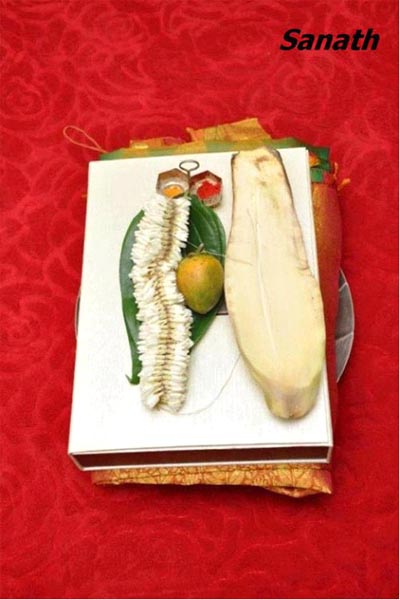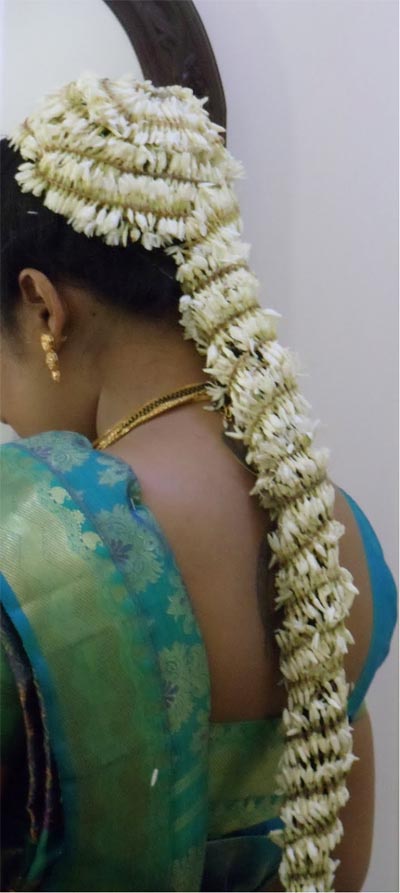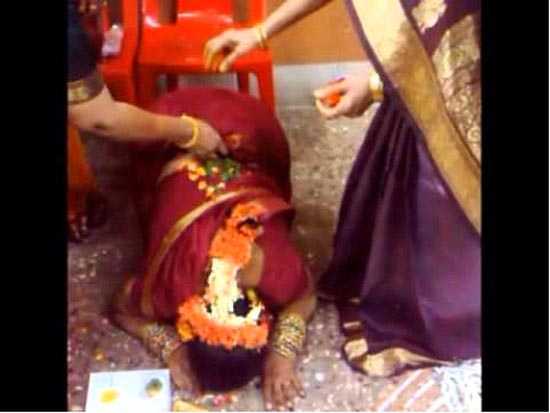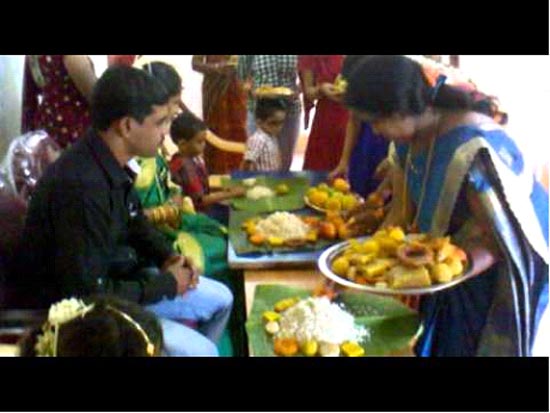Customs and traditions have always been played a role of great importance from birth till death in the lives of the people belonging to different parts of the world and has become a part, occupied the central stage and witness to innumerable customs. These varied customs invoke great curiosity in the minds of the younger generation and want to learn its significance. The customs to a great extent reflect the lifestyle of the people in the society.
What is Seemantham?
Most cultures in the world over, have ceremonies/celebrations before a baby is born.Mostly, all over the world these are celebrated in the 7th month of pregnancy (Usually the odd numbered months-7th or 9th for good luck-but the 9th month might be too late).There are many different ways of celebrations but the universal essence is to make the Mom-to-be feel happy, special and even pamper her and showering her, baby and not to forget the father-to-be with love and blessings. The common theme is to bless expecting mom and pray for the well being of the mother and the baby. Here though I mentioned about different ways of celebrations in different parts, I am emphasizing more importance to Tuluva style Bayake celebration.
The essence of the traditional Indian celebration (unity in diversity)
India being a vast and diverse sea of humanity has many different customs and celebrations in different areas—Baby Shower (In western countries) Godh Bharai (North Indian Hindus), Valakaappu (Tamil Hindus) and Seemandham (South Indian Hindus) Seemantha (Karnataka Hindus) Dohal Jeevan (Maharashtra) Bayake (Tulunadu-coastal area) and to name a few. Gujarat, Bengal etc. also have their own twists on these ceremonies.
Whatever the culture, system or custom may be, the main objective, central theme of the celebration will be same everywhere to bless the Mom-to-be and welcome the child (new member) to the family. It is the mom-to-be who is showered with blessings and bounty – cash, clothes or even jewellery – a sort of a “mother-to-be shower”. Also, traditionally it is attended by the women-folk.
According to the Indian tradition, it is considered inauspicious to buy any clothes or other items for the baby before the baby is born (possibly because in olden days, the percentage of babies dying during childbirth was high).
· In fact when the baby is born, the baby is made to wear old clothes of some other member of the family. The thinking is that the material will be soft for the soft baby skin and the positive family vibes and values will be passed to the baby.
· Of course with global influences, this is changing in many families.
So, what is a baby shower?
Baby showers are very popular in the United States. Friends and family come and “shower” the new mom-to-be with gifts for the baby – a very practical way to help a couple gear up (from baby clothes to a pram) for the new baby and of course to pamper the mom-to-be. Here is how it is celebrated:
What is Bayake (in Tulu) –Seemantha (in Kannada)? (Coastal region style)
A Bayake is nothing but a baby shower ceremony, (in western country) being celebrated the first pregnancy of the daughter in law of the house at which presents are given to her. Mom to be is showered with love and blessings at the Bayake (Bayake (in Tulu= means desire) and has to now prepare herself for the final months before delivery and can eat whatever she loves to eat unlike in the initial months of pregnancy as there is a limitations to what the pregnant mother can eat, whatever heart desires.
When should the Bayake be held?
Bayake is held when the woman is in her 5th or 7th or 9th months of pregnancy, usually the odd numbered months are chosen for good luck – but the 9th month might be too late. So, the celebration is usually held at the seventh month to welcome the new member to the family and to bless the expectant mother with the joys of motherhood.
Who should throw the Bayake?
Bayake is traditionally and most commonly hosted by the mother-in-law of the pregnant woman (would be mother) after consulting a priest or an astrologer for good day, date and auspicious time. The people from mother to be’s (pregnant woman’s) house go to their daughter’s mother-in-law’s house and the two families have a get-together with delicious food and parents of mother to be’s take this as an opportunity to take their daughter to their place for the delivery and the 40 days after the delivery. Due to space constraints in modern times Bayake is held in halls.
Who should be invited to the Bayake/Baby shower?
Traditionally involvement of women-folk is more than men but as dads are being involved, inviting both women and men is getting more popular now a days. It all depends on what sort of function and where you’re planning. The guest list is usually made up of close friends and family.
Initiating the Cooking Process:
It was the traditional and custom of preparing foods at home in the olden days. The pregnant woman places a big traditional large round boiler of copper (Kadai=cauldron) on a hearth (an earthen oven) or on stove and pours oil into it to initiate the cooking process and then others will take over the cooking process from her.
Besides in many places as mark of prestige, status Cock-Fights among robust cocks (Kori Katta in Tulu, Koli anka in Kannada) were being conducted depending upon financial condition of in-laws house on the previous day of the Bayake (Seemantha).The victorious cocks will be kept at home after being given round of first aid and defeated cocks End up on the Bayake table the next day.
Kori Budpini (matured hen (Laaki) before started laying eggs):
It is a custom which has been followed since generation that a matured Hen before starting lying eggs (Telavu Laaki in Tulu) is taken to the in-laws house from the pregnant woman’s mother house. Pregnant woman after taking her bath in the morning wears a new sari and proceeds to the ‘Tulsi Katta’ (Sacred place in front of the house with Tulsi plant (a sacred and holy basil) to pray. She stands facing rising sun in the east after brief prayer. Then either sumangali mother-in-law or sister-in-law takes the hen and wets its legs, removes few feathers and feeds rice grain to the hen. Then she blesses the girl over her head with Hen three times and left the Hen in mother-in-laws compound to live and lay eggs. The belief and significance of this ritual is that if there is any bad effects/Dosha ,it is passed on to the hen.It is of the common belief that the hen will lay the eggs and hatch chicks during the same time of the daughter-in-law’s delivery.
Presenting of Flower (Poo) Sari (Seere):
Mother-in-law keeps one bundle (Chendu) of Jasmine (Mallige),an auspicious green color silk sari,(Patte Seere) blouse,Jewellery to be gifted, green and red bangles along with sealed Pingara ( fertile tender Areca flower),odd number of betel leaves and areca nuts and Kum Kum(Vermilion) in a steel or copper plate(Harivana).
Sometimes even two saris are gifted. It is then kept in the Daiva Sthana of Varthe (as she is a female daiva) or in front of Goddess Laxmi or any other Goddess, to seek blessings. Both the families pray. The master of the house prays to the family Daivas, gods & seeks blessings. Then the would be mother stands on a mat with five ladies from her house behind her facing east. The Mother-in-laws women relatives stand behind the mother-in-law. The Mother-in-law gives the plate filled with all the above said items to the pregnant woman’s female relatives over her head three times and finally hands it to the would be mother. The pregnant thanks her Mother-in-law by touching her feet. She then opens the Pingara, (Inflorescences are crowded inside) and removes 1 petal (yesal) and keeps on her hair.
The significance of Green color is that it is color of nature, fertility, life and growth.
Dressing up of the Mom- to be:
The pregnant woman then gets ready for the function. She will now wear the green sari, blouse & the jewellery gifted to her. Her hair will be decked up with Jasmine flowers. She will dress like a bride and will wear a lot of jewellery. Her family members will help her. She will also slip into her wrists the green and red glass bangles. She will carry in her right hand the betel nut, betel leaves and small silver knife (Bolli da gejje katti) to protect her and her unborn child both from evil spirits.
Bayake Ceremony:
When she is ready she will be led by her sister-in-law (husband’s sister). A tall kaldeepa (wick lamp) is kept to the right of the chair. It is decorated with flowers and lit by the mother-in-law. The sister-in-law and would be mother will take three rounds clockwise of the decorated chair and the stool kept in front of the chair. The pregnant woman sits on the decorated chair. Then the Baike ceremony begins.
A big flat Harivana (Plate) with two handles is kept on a stool in front of her. This Harivana is traditionally used for such occasions. Or a broad and flat wooden marai (Plate) can also be used. Three kodi banana leaves (front-top half of the banana leaf) is laid on the plate as it’s used in all auspicious ceremonies. The function takes place in the main hall of the house (chavadi) and the pregnant woman always faces east.
Laying out a feast before her or Balasuni:
Fruits, assorted sweets and savories are served to the pregnant woman by the mother-in-law. Usually 9 or 11 varieties of food items are served to the pregnant woman. Odd number is chosen for good luck. The items should also be of big size. Usually 10 numbers of each item is prepared. One extra may be made to be on the safer side as broken sweets & savories are not served to the expectant mother. To serve, take 10 and serve only 9. One is saved and should be taken back. Now days the mother-in-law takes these extra items back to her home.
The sequences are as follows:
1. First serve on one side of the banana leaf, 9 spoons of drumstick leaves/nudge soppu da playa. If those leaves are not available padpe or any other greens also can be served. One or three boiled eggs are then served.
2. Two palmfuls of Kajjaya has to be served three times. (Sweet puffed Rice to which jaggery & coconut are added) or sweet rice powder. (urpel/ boiled rice is roasted then powdered)
3. Then 9 athrasa, 9 chakulis, 9 seke adye, 9 poddol da unde, 9 boondi laddoo and bananas. A whole bunch of bananas (panne) is served on the top. Arrange the laddoos in circles so that they don’t fall. Remember, you have to pile and arrange the food.
4. 1 piece of acchi bella (jaggery) is kept on the top to which 9 spoons of cow ghee is poured. The whole set up should look like a chariot.
Athrasa, seke adye, chakuli, puffed rice kajjaya, nurge da soppu da palya, eggs are a must. Other items could be halwa, holige, saat, malpuri, thambittu, yellappa, Kara kaddi, jelebi, Jahangir, boondi laddoo, poddol da unde, eatables of her choice, sweetmeats she likes are served.
Aarti:
Then 5 sumangalis (A Sumangali is a married woman living with her husband) perform aarti to the expectant mother while she remains seated. The arati tray (harivana) is rotated in a circular motion in front of the would be mother in clockwise direction. They will sing a Shobana or a baby shower song. They will put kum kum (to ward off the evil eye) and then put sese. (Rice is placed or thrown on her head) Aarti is performed to welcome the new member and to celebrate the auspicious occasion. Now a day the mother-in-law opens the pingara and gives it to her son. He puts the pingara on her hair. This Pingara is not given earlier.
Feeding the Children:
Two children, a female and male child are made to sit on either side of the pregnant woman. Then the pregnant woman feeds the male or the female child an egg depending on what child she wants first and then takes a bite of the boiled egg. Then the mother-in-law tells the pregnant woman to eat the greens. A tumbler of Kali (toddy) is also kept for her to drink. Now a days they keep a glass of milk to which puffed rice is added. A few family members feed the pregnant woman a spoon of the milk and few goodies from her tray. Other invitees will now put sese and bless her.
The remaining food on her harivana is sent with her to her mother’s house which she will distribute some to her relatives & some she will enjoy at leisure. In the olden days the journey to her mother’s home was long and tedious. So food was provided to the pregnant lady to eat during her journey.
After the above ceremony the harivana on which the food was served is gently lifted & put back, in keeping with the dictates of tradition. The pregnant woman can now get up from her chair and she will be helped up by her sister-in-law
Lunch:
The pregnant woman will be served a typical non vegetarian fare by her mother-in-law on a Banana leaf (Only half top portion of the banana leaf is used).
In some parts of Tulunadu after serving the pregnant woman, the same food is served to a Sumangali tribal mother on a tadpe (a medium plate like thing made up of dried stem of creeper plants). Along with the food, the saved sweets during the serving ceremony are also given to her with presents like money and sari. The pregnant woman pours a little coconut oil or til (gingili oil on the tribal’s hair. Usually a ranka (oil measurement in Tulu) of oil is given to her. The tribal woman will carry the rest home. The tribal woman will now touch the pregnant woman & bless her. This custom is rarely followed today!
· The invited guests enjoy a grand traditional Bunt feast.
Exit:
The exit from the place of the Bayake takes place at an appointed time, according to the muhurta. No important function is considered complete without invoking the blessings of the elders by touching their feet. So the pregnant woman will seek the blessings of all elders present. After receiving aashirwada or blessings she takes her leave. When she goes to her mother’s house she is given a packet of medicinal herbs to be used after delivery in her mum’s house.
Thammana(Feast):
The mother of the pregnant woman also arranges for a non vegetarian feast for her once she reaches her home. She will also give gifts to her daughter, blessings and prays for her and the baby’s wellbeing.
How many Bayake should be held?
Usually, only one Bayake is held for the daughter-in-law. If she conceives again after a gap of 12 years, then another Bayake is held. A second bayake is also held when a she is carrying her 13th child. Here it is important to note that all her 12 children should be alive.
Isn’t amazing how rich our Tulunadu customs are? The customs have got diluted over the years and the way it is done now is the modern version. Bayake is a wonderful way for family & friends to come together and celebrate the arrival of a new member. It remains to be seen how many generations can take this custom forward.
Shekar moily











